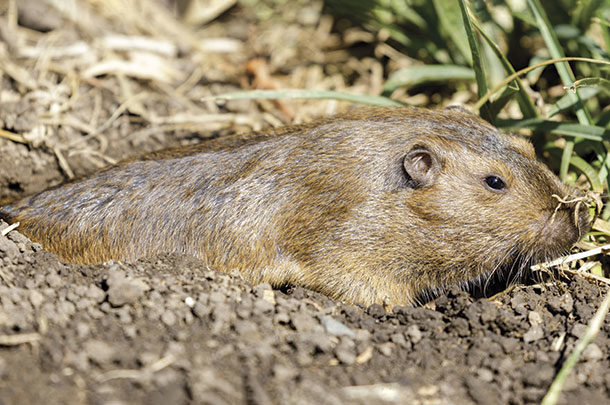Pocket gophers are often the most damaging vertebrate pests in alfalfa. The amount and form of damage they cause can be quite varied but includes a loss in vigor and/or mortality of plants, damage to subsurface drip lines and loss of irrigation water down burrow systems. If left unchecked, pocket gophers will cause extensive damage to alfalfa (8.8% loss in revenue when present). This damage includes consumption of taproots and aboveground vegetation. Pocket gopher mounds can result in additional problems including serving as weed seedbeds, lowering quality of hay and causing damage to farm equipment.
Primary tools continue to include rodenticides, burrow fumigants and trapping, although other tools such as cultivation, burrow flooding, biocontrol and repellents may have a role in effective management programs as well.
Toxic baits
There are three primary rodenticides for pocket gopher control: strychnine, zinc phosphide and anticoagulants (e.g., chlorophacinone and diphacinone). Both strychnine and zinc phosphide are considered acute toxicants. This means they kill after a single feeding. Strychnine has generally been the more effective of the two and comes in a 0.5% concentration. Zinc phosphide is also available for pocket gopher control; it comes in a 2% concentration. Bait acceptance can be an issue with zinc phosphide, as it has a distinctive odor and taste pocket gophers are often averse to. This can limit the efficacy of zinc phosphide baits.
Anticoagulants such as chlorophacinone and diphacinone are multiple feed toxicants. With these rodenticides, pocket gophers generally need to consume the bait multiple times over the course of three to five days to receive a lethal dose. This means larger amounts of bait are required to maintain a ready supply over this time period. Because of this, acute toxicants have often yielded better results for pocket gopher control.
Extensive laboratory trials have shown that strychnine products are far more efficacious than other rodenticides currently registered for pocket gopher control. Subsequent field trials indicated 100% removal of pocket gopher populations across three vineyards, so strychnine does still appear to be highly efficacious. However, pocket gophers do develop a behavioral or physiological resistance to strychnine if repeatedly used over time. Therefore, strychnine baiting should be used only as one part of an integrated pest management (IPM) program.
There are two primary methods for baiting in alfalfa fields: hand baiting with an all-in-one probe and bait dispenser, and a burrow builder. Hand baiting can be effective if you have relatively few pocket gophers in a field. For this approach, an all-in-one probe and bait dispenser is used to locate a tunnel. The bait is then directly deposited into the tunnel. The opening left by the probe is covered up with a dirt clod or rock to prevent light from entering the burrow. When using this method, care must be taken not to bury the bait with loose dirt, as this will limit access to the bait.
Typically, it is recommended that burrow systems be treated at least twice to maximize efficacy. Recent research has shown the experience of the individual who applies the bait is very important; those applicators who have been properly trained on how to use the equipment, and who can detect the difference between extant versus back-filled tunnels, are more than twice as efficacious as those individuals who have not received the proper training.
Fumigation
Primary fumigants for burrowing rodent control have historically included gas cartridges and aluminum phosphide. Studies have shown that gas cartridges are not effective for pocket gophers. Aluminum phosphide, however, is quite effective. Aluminum phosphide is a restricted-use material; it can only be used by or under the direct supervision of a certified applicator. That said, it is quite effective and has a low material cost if used over small areas.
The primary method for applying aluminum phosphide is similar to that of hand baiting. You use a probe to find a pocket gopher tunnel, then wiggle the probe to enlarge the opening (if the probe hole is not already large enough to allow passage of the aluminum phosphide tablets into the tunnel), and drop the label-specified number of tablets or pellets into the tunnel. You then seal up the opening to eliminate light from entering and the toxic gases from exiting the tunnel. Once again, care must be taken not to bury the tablets with loose soil, as this will render them ineffective.
Typically, each burrow system is treated twice to maximize efficacy. The key with aluminum phosphide treatments is to only apply when soil moisture is relatively high. If you can ball up a clump of soil at the tunnel depth, and it maintains that ball in your hand, then soil moisture is high enough to fumigate; if the clump falls apart in your hand, it is too dry. Because of this, fumigation is typically most effective in late winter and early spring. However, fumigation after irrigation can also be a good strategy.
In addition to aluminum phosphide, carbon monoxide-generating machines can now be used to control pocket gophers. As their name implies, these devices generate carbon monoxide and inject it into the burrow systems, which then asphyxiates the inhabitants. Trials have indicated this approach is moderately effective (56% to 68%), although efficacy is less than typically observed with trapping, aluminum phosphide and strychnine. Additionally, equipment can be expensive to purchase. However, many more burrow systems can be treated during a day of application with this approach, so these machines likely have utility moving forward, particularly for growers and pest control professionals who have large acreage to treat.
Trapping
Trapping is safe and one of the most effective, although labor-intensive, methods for controlling pocket gophers. Nonetheless, the cost and time for application is often offset by effectiveness. Several types and brands of pocket gopher traps are available. The most common type is a two-pronged pincher trap. For trap placement, the first step is to probe near a fresh mound to find the main tunnel, which often is on the side closest to the plug of the mound. The main tunnel usually is 6 to 8 inches deep; the probe will drop quickly about 2 inches when the tunnel is encountered. Traps will then need to be placed in as many tunnels as are present, as you will not know which side the pocket gopher currently is using.
Various attractants have been tested to see if they will increase capture success. They do not appear to increase capture success, although if using covered trap sets, there could be a slight increase in capture success when using an attractant such as peanut butter. Human scent also does not influence capture success, so there is little reason to worry about handling traps with bare hands. Trap sets are typically only operated for 24 hours. If no activity is present in that time frame, they should be moved to a new location to maximize capture probabilities.
Pincher-type traps can also be placed in lateral tunnels, which are tunnels that lead directly to the surface. To trap in laterals, the plug is removed from a fresh mound and a trap placed into the lateral tunnel so the entire trap is inside the tunnel. Pocket gophers will come to the surface to investigate the tunnel opening and will be caught. This approach is quicker and easier to implement than trapping in the main tunnel. However, trapping in lateral tunnels may be less effective at certain times of the year (e.g., summer) and for more experienced and larger pocket gophers (e.g., adult males).
Portions of this article originally appeared in the proceedings from the 2021 Western Alfalfa and Forage Symposium.

-
Roger A. Baldwin
- UCCE Wildlife Specialist
- University of California – Davis
- Email Roger A. Baldwin










